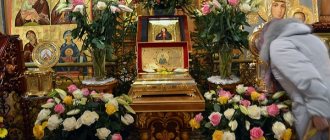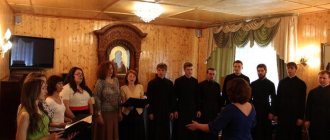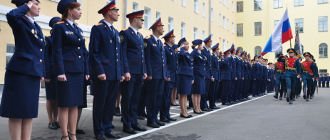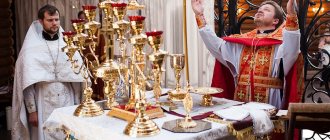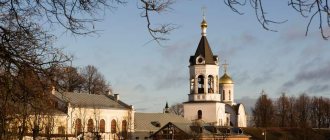All-night vigil
The meaning and structure of the all-night vigil
An all-night vigil, or all-night vigil, is a divine service, which, as a rule, takes place in the evening on the eve of Sundays and holidays. The church day, according to biblical tradition, begins in the evening, and this evening service is directly related to the event celebrated the next day.
In ancient times, the all-night vigil began after sunset and lasted throughout the pre-holiday night. Nowadays, this service usually ends late in the evening, but its former historical name - all-night vigil - has been preserved.
The All-Night Vigil reflects the history of the salvation of the human race and consists of three parts, or sections: Great Vespers, Matins and the first hour.
Great Vespers
Initial exclamation and initial psalm. The service begins with the silent burning of the altar, which marks the beginning of the creation of the world, when the Spirit of God hovered over the primordial substance of the earth. Then the priest with the first exclamation glorifies the Creator of the world: Glory to the Holy, and Consubstantial, and Life-giving, and Indivisible Trinity, always, now and ever, and to the ages of ages - and three times calls on the believers: Come, let us worship our King God... In response, the choir solemnly sings 103- th psalm, glorifying the wisdom of God. The royal doors opened at this moment and the priest censing the entire temple symbolize paradise, that is, the state of direct communication between people and God, in which the first people lived.
Lamp prayers and great litany. Immediately after the incense burning of the temple, the royal doors are closed, which recalls the expulsion of the first people from paradise for the sin of disobedience to God.
The priest, showing the image of the repentant Adam, stands in front of the closed royal doors with his head uncovered as a sign of humility and quietly reads the seven penitential prayers of light. These prayers are called lamp prayers, since since ancient times vespers have been performed with lit lamps. Then the deacon, on behalf of all believers, pronounces the great litany - a collection of short prayer requests and appeals to the Lord about the earthly and spiritual needs of the believers. The Great Litany is often called by its first words - Let us pray to the Lord in peace - a peaceful litany.
First antiphon. After the peaceful litany, selected verses from the first three psalms of the Psalter (first antiphon) are sung and the litany is pronounced again, but this time shortened, small. Next, stichera on the Lord, I cried, are heard - spiritual hymns that alternate with verses from the Psalter. The verses before the stichera are of a penitential, prayerful nature, expressing the sadness and sorrow of humanity until the coming of Christ, and the stichera speak about the event of the holiday, about its meaning, about New Testament joy and light. The last stichera is called the Theotokos, or dogmatist, and is dedicated to the Mother of God. It reveals the church teaching about the incarnation of the Savior from the Virgin Mary. During the singing of the stichera, censing of the entire temple is performed again.
Small entrance. During the singing of the dogmatist, the royal doors are opened as a sign that paradise is reopening with the coming to earth of the Son of God Jesus Christ, and the small evening entrance takes place. The priest comes out through the side door of the iconostasis following the deacon carrying the censer, just as the Son of God appeared to people before John the Baptist, and in the same order they enter the altar through the royal doors of the iconostasis. At this time, the choir sings the Quiet Light - a song to the Son of God, the Lord Jesus Christ, Who, according to the Apostle John the Theologian, is the true Light, unevening, eternal, unquenchable (see: Rev. 21: 23; 22: 5). This song contains a statement of one of the most important dogmas of Orthodoxy - the confession of Christ as the visible Person of the Most Holy Trinity.
Proverbs, litanies. After greeting all those praying with the words of the Savior: Peace to all! - follows the prokeimenon - a short saying from the Holy Scriptures, which is pronounced before reading a large passage from the Old or New Testament. The passage itself is called paremia (from the Greek παροιμία - “parable”). According to the instructions of the Church, proverbs are read on the days of great holidays and contain prophecies about an event or person remembered on that day (praise of a holiday or saint). After the prokemna and paremia, the deacon pronounces an amplified (that is, intensified) litany, then the prayer is read or sung: Grant, O Lord, that this evening we may be preserved without sin. After it, the deacon pronounces a litany of petition.
Litiya, prayer “Now you let go.” After the litany, litia is performed (from the Greek λιτή - “intense prayer”). The clergy, when singing stichera containing the glorification of the saint of a given day or holiday, leave the altar into the vestibule, which means the exit of the Church into the world for the purpose of a prayer mission, and read lithium prayers.
After the litia, the choir sings stichera on stikheron (stichera with verses from psalms), which tell about the sacred event being celebrated. After the stichera, the prayer Now You Let Go is sung, pronounced by Saint Simeon the God-Receiver, who was honored before his death to see the born Savior of the world. This song symbolizes the end of Old Testament history. Then (if the vigil is on Sunday) a hymn dedicated to the Virgin Mary sounds: Virgin Mary, Rejoice - since the New Testament era begins with the birth of the Mother of God.
At this time, a table with a vessel containing five loaves, wheat, wine and oil is placed in the middle of the temple, which are then consecrated in memory of the Savior feeding five thousand listeners of His sermon with five loaves.
During Matins, the priest anoints the worshipers with consecrated oil, and then sliced consecrated bread is distributed to the believers.
At the end of Vespers, the priest gives the worshipers an ancient blessing in the name of the incarnate Jesus Christ with the words: The blessing of the Lord is upon you, through His grace and love for mankind always, now and ever, and unto ages of ages .
Matins
Six Psalms. The second part of the all-night vigil - Matins - begins with the joyful song of angels singing the birth of Christ: Glory to God in the highest, and on earth peace, good will towards men . Then the candles in the temple are extinguished, which marks the night on which Christ came to earth, and the image of the darkness in which all humanity was before the coming of the Savior. The reader in the middle of the temple begins to read the Six Psalms, which contains six psalms reflecting the sinful state of people and their hope for salvation. During the reading of the Six Psalms, the priest, first in the altar and then on the pulpit, prays to God to send God’s mercy to people.
Kathismas. After the end of the Six Psalms, the Great Litany is recited again, as at the beginning of the All-Night Vigil. Then the singing from Psalm 117 is heard: God is the Lord, and He has appeared to us, blessed is he who comes in the name of the Lord - and a troparion is sung - a short hymn telling about the suffering of Christ and His resurrection from the dead or dedicated to a holiday or a celebrated saint. The candles are lit again and the reading of kathismas begins. The Greek word κάθισμα means “sitting,” since according to church regulations, worshipers are allowed to sit while reading kathismas. The entire Psalter, consisting of 150 psalms, is divided into 20 kathismas, that is, groups or chapters of psalms. At the all-night vigil, two kathismas, defined by the charter, are always read.
Polyeleos. Then the polyeleos begins - the most solemn moment of the all-night vigil, dedicated to the memory of the resurrection of Jesus Christ. This service received the name polyeleos (from the Greek πολυέλεος - “many mercy”) because during the polyeleos verses of praise from the psalms are sung and the words are repeated: for His mercy endures forever . On the polyeleos, the royal doors open, the entire temple is illuminated, the clergy come out of the altar, censing the temple. These sacred ceremonies depict the rise of Christ from the tomb and the appearance of His disciples. This is followed by the reading of the Gospel about the appearance of the risen Savior. On great holidays, the glorification of a holiday or saint is sung on the polyeleos and the Gospel relating to the celebrated event or the glorification of the saint is read.
Canon. After reading the Sunday passage from the Gospel, it is taken to the middle of the church, and the parishioners venerate it. On other holidays, believers kiss the holiday icon. The priest anoints them with blessed oil and distributes consecrated (at litia) bread. At this time, the canon is read (from the Greek κανών - “rule”). A canon is a collection of nine parts (songs) compiled according to a certain rule. The first verse of each song is sung, it is called irmos, and the remaining verses of each part (song) are read and called troparia. Irmos reflect Old Testament times and the history of our salvation. The troparia of the canon are dedicated to New Testament events and glorify the Lord, the Mother of God, and the saints whose memory is celebrated on this day.
Stichera on praise. In ancient times, dawn was approaching the end of the reading of the canon, and this approach of light is marked by a special chant - the luminary chant, after which the verse Let every breath praise the Lord is sung and the 148th, 149th and 150th psalms are read. These three psalms are called praise psalms because the word praise . These three psalms are associated with special stichera, which, like other stichera at the all-night vigil, praise the gospel or church event celebrated on a given day (the memory of a particular saint or saints).
Great doxology. After the singing of psalms of praise there follows a great doxology. The royal doors open and the priest proclaims: Glory to You, who showed us the light! (In ancient times, this exclamation preceded the appearance of the solar dawn.) The choir sings a great doxology, which begins with the words: Glory to God in the highest, and on earth peace, good will toward men . In this sublime and solemn song we praise, bless, worship, glorify and thank God.
Matins at the All-Night Vigil ends with intense and petitionary litanies - the same ones that were read at the beginning of the All-Night Vigil at Great Vespers. Then the final blessing of the priest is given.
First hour
Following the blessing of the priest the first hour , consisting of the reading of psalms and prayers, in which we thank God for the coming day and ask for guidance on the path pleasing to Him during the coming day. The priest leaves the altar without his festive vestments. The temple is in twilight.
The All-Night Vigil ends not with a joyful celebration, but with a humble and quiet appeal to God. The Lord accomplished our salvation, defeated death, showed the way to the Kingdom of Heaven, but we can overcome this path only by working daily in fulfilling His holy commandments, constantly asking for His help.
07.06.2021


